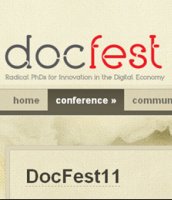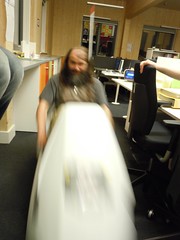 Yesterday I started to read John Maeda’s “The Laws of Simplicty” whilst sitting by Fiona’s stall at the annual Tiree agricultural show, then finished before breakfast today. Maeda describes his decision to cap at 100 pages1 as something that could be read during a lunch break. To be honest 30,000 words sounds like a very long lunch break or a very fast reader, but true to his third law, “savings in time feel like simplicity”2, it is a short read.
Yesterday I started to read John Maeda’s “The Laws of Simplicty” whilst sitting by Fiona’s stall at the annual Tiree agricultural show, then finished before breakfast today. Maeda describes his decision to cap at 100 pages1 as something that could be read during a lunch break. To be honest 30,000 words sounds like a very long lunch break or a very fast reader, but true to his third law, “savings in time feel like simplicity”2, it is a short read.
The shortness is a boon that I wish many writers would follow (including me). As with so many single issue books (e.g. Blink), there is s slight tendency to over-sell the main argument, but this is forgiveable in a short delightful book, in a way that it isn’t in 350 pages of less graceful prose.
I know I have a tendency, which can be confusing or annoying, to give, paradoxically for fear of misunderstanding, the caveat before the main point. Still, despite knowing this, in the early chapters I did find myself occasionally bristling at Maeda’s occasional overstatement (although in accordance with simplicity, never hyperbole).
One that particularly caught my eye was Maeda’s contrast of the MIT engineer’s RFTM (Read The F*cking Manual) with the “designer’s approach” to:
marry function with form to create intuitive experiences that we understand immediately.
Although in principle I agree with the overall spirit, and am constantly chided by Fiona for not reading instructions3, the misguided idea that everything ought to ‘pick up and use’ has bedeviled HCI and user interface design for at least the past 20 years. Indeed this is the core misconception about Heidegger’s hammer example that I argued against in a previous post “Struggling with Heidegger“. In my own reading notes, my comment is “simple or simplistic!” … and I meant here the statement not the resulting interfaces, although it could apply to both.
It has always been hard to get well written documentation, and the combination of single page ‘getting started’ guides with web-based help, which often disappears when the web site organisation changes, is an abrogation of responsibility by many designers. Not that I am good at this myself. Good documentation is hard work. It used to be the coders who failed to produce documentation, but now the designers also fall into this trap of laziness, which might be euphemistically labelled ‘simplicity’4.
Personally, I have found that the discipline of documenting (in the few times I have observed it!) is in fact a great driver of simple design. Indeed I recall a colleague, maybe Harold Thimbleby5, once suggested that documentation ought to be written before any code is written, precisely to ensure simple use.
Some years ago I was reading a manual (for a Unix workstation, so quite a few years ago!) that described a potentially disastrous shortcoming of a the disk sync command (which could have corrupted the disk). Helpfully the manual page included a suggestion of how to wrap sync in scripts that prevented the problem. This seemed to add insult to injury; they knew there was a serious problem, they knew how to fix it … and they didn’t do it. Of course, the reason is that manuals are written by technical writers after the code is frozen.
In contrast, I was recently documenting an experimental API6 so that a colleague could use it. As I wrote the documentation I found parts hard to explain. “It would be easier to change the code”, I thought, so I did so. The API, whilst still experimental, is now a lot cleaner and simpler.
Coming back to Maena after a somewhat long digression (what was that about simplicity and brevity?). While I prickled slightly at a few statements, in fact he very clearly says that the first few concrete ‘laws’ are the simpler (and if taken in their own simplistic), the later laws are far more nuanced and suggest deeper principles. This includes law 5 “differences: simplicity and complexity need each other”, which suggest that one should strive for a dynamic between simplicity and complexity. This echoes the emphasis on texture I often advocate when talking with students; whether in writing, presenting or in experience design it is often the changes in voice, visual appearance, or style which give life.
the simplest interface?
I wasn’t convinced by Maeda’s early claim that simple designs were simpler and cheaper to construct. Possibly true for physical prodcuts, but rarely so for digital interfaces, where more effort is typically needed in code to create simpler user interfaces. However, again this was something that was revisited later, especially in the context of more computationally active systems (“law 8, in simplicity we trust”), where he contrasts “how much do you need to know about a system?” with “how much does the system know about you?”. The former is the case of more traditional passive systems, whereas more ‘intelligent’ systems such as Amazon recommendations (or even Facebook news feed) favour the latter. This is very similar to the principles for incidental and low-intention interaction that I have discussed in the past7.
Finally “The Laws of Simplicity” is beautifully designed in itself. It includes many gems not least those arising from Maeda’s roots in Japanese design culture, including aichaku, the “sense of attachment one can feel for an artefact” (p.69) and omakase meaning “I leave it to you”, which asks the sushi chef to create a meal especially for you (p.76). I am perhaps too much of a controller to feel totally comfortable with the latter, but Maeda’s book certainly inspires the former.
- In fact there are 108 pages in the main text, but 9 of these are full page ‘law/chapter’ frontispieces, so 99 real pages. However, if you include the 8 page introduction that gives 107 … so even the 100 page cap is perhaps a more subtle concept than a strict count.[back]
- See his full 10 laws of simplicity at lawsofsimplicity.com[back]
- My guess is that the MIT engineers didn’t read the manuals either.[back]
- Apple is a great — read poor — example here as it relies on keen technofreaks to tell others about the various hidden ways to do things — I guess creating a Gnostic air to the devices.[back]
- Certainly Harold was a great proponent of ‘live’ documentation, both Knuth’s literate programming and also documentation that incorporated calculated input and output, rather like dexy, which I reported after last autumn’s Web Art/Science camp.[back]
- In fairness, the API had been thrown together in haste for my own use.[back]
- See ‘incidental interaction” and HCI book chapter 18.[back]








